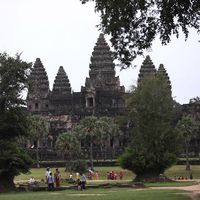Apsara Authority

The Authority for the protection of the site and the Management of the Region of Angkor (APSARA National Authority or ANA) was created in 1995 to answer to inscription of the Angkor Site on the World Heritage List.
The main missions delegated to the National Authority APSARA are as follows:
- Ensure in the region of Siem Reap/Angkor, the protection, the preservation and the valuation of national cultural property,
- Conceive and lead the development of cultural tourism in the region of Siem Reap/ Angkor
- Carry out sustainable development to contribute to the implementation of the policy of the Royal Government of Cambodia for poverty reduction
- Establish partnerships with provincial and territorial authorities
- Cooperate with institutions and organizations, both Khmer and Foreign, which have objectives answering the vocation of ANA and are operating in the region.
During 25 years of activities, APSARA National Authority has ensured the gradual transfer of skills to Cambodian professionals, keeping active at the same time the field operations of the international cooperation. It is, with its almost 4,000 employees, the first employer of the region. It plays a crucial role in the management of Angkor, World Heritage Site, under the guidance of the Ministry of Culture and Fine Arts. It has answered the call of the Cambodian people voiced through His Majesty the King and the international community.
On the 40,000 hectares of the park, a population of approximately 125,000 people, distributed through 112 villages. To allow families which increase in numbers to have additional dwellings without endangering the integrity of the World Heritage Site, ANA fitted out a 1,000-hectare site, and eco-village at Run Ta EK, to facilitate their re-settlement outside the Angkor Park. At Angkor, the population is firmly bound to the land and their traditions, even before the inscription of the site on the World Heritage List.
Similar content
from - to
19 Feb 2013 - 31 Jul 2013
posted on
12 Jan 2021
04 Feb 2015 - 06 Feb 2015
deadline
22 Jul 2020
deadline
30 Jun 2015



